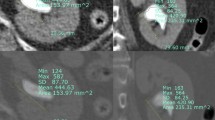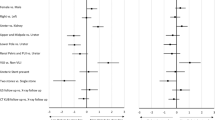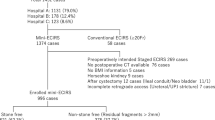Key Points
-
The need for standardized outcome reporting following percutaneous nephrolithotomy resulted in the creation of the four major validated scoring systems Guy's stone score, S.T.O.N.E. nephrolithometry, CROES nomogram, and S-ReSC score
-
The four scoring systems have similar ability to predict postoperative stone-free rate but their ability to predict complications varies; the Guy's stone score is the only system predictive of both stone-free rate and complications
-
The S.T.O.N.E. score provides the best combination of ability to predict stone-free rate, minimal subjectivity when scoring, and simplicity in clinical application
-
The S-ReSC score provides similar information to the S.T.O.N.E. score but it was created on the basis of expert opinion and no studies exist that compare S-ReSC with other systems
-
The CROES nomogram was created using data from a large multicentre database but its application in daily practice is hindered by the need to know multiple patient characteristics for score calculation
-
Increasing use of scoring will provide additional data on factors that are most predictive of stone-free rate and complications following PCNL and might help create an optimum unified system in the future
Abstract
Percutaneous nephrolithotomy has become the preferred treatment modality for patients with large renal calculi. The technique provides excellent stone clearance, but complication rates are higher than those of minimally invasive techniques, such as ureteroscopy and shockwave lithotripsy. Guy's stone score, S.T.O.N.E. nephrolithometry, the CROES nomogram, and S-ReSC are contemporary scoring systems introduced to provide standardized grading of stone complexity and outcomes of percutaneous stone surgery. Guy's stone score is easy to apply and has been validated in multiple studies. The S.T.O.N.E. score is based on factors determined through CT imaging, which is the currently preferred imaging modality for patients with nephrolithiasis. The CROES nomogram was developed from data in a large multicentre database and has high statistical power. Determination of the S-ReSC score relies on stone location only, providing a simple approach to grading disease complexity. Each system has advantages and disadvantages, but several studies suggest that their ability to predict stone-free rate is comparable. The optimal system should have a high predictive ability, should be simple to use and should be widely applicable. Additional studies are required to evaluate patient clinical factors that influence stone complexity and are predictive of outcomes. A future unified scoring system might incorporate the strengths of each currently available system and optimize care of patients with nephrolithiasis.
This is a preview of subscription content, access via your institution
Access options
Access Nature and 54 other Nature Portfolio journals
Get Nature+, our best-value online-access subscription
$29.99 / 30 days
cancel any time
Subscribe to this journal
Receive 12 print issues and online access
$209.00 per year
only $17.42 per issue
Buy this article
- Purchase on Springer Link
- Instant access to full article PDF
Prices may be subject to local taxes which are calculated during checkout




Similar content being viewed by others
References
Scales, C. D., Smith, A. C., Hanley, J. M. & Saigal, C. S. Prevalence of kidney stones in the United States. Eur. Urol. 62, 160–165 (2012).
Brown, J. Diagnostic and treatment patterns for renal colic in US emergency departments. Int. Urol. Nephrol. 38, 87–92 (2006).
Preminger, G. G. et al. AUA guideline on management of staghorn calculi: diagnosis and treatment recommendations. J. Urol. 173, 1991–2000 (2005).
Turk, C. et al. EAU guidelines on interventional treatment for urolithiasis. Eur. Urol. 69, 475–482 (2016).
De, S. et al. Percutaneous nephrolithotomy versus retrograde intrarenal surgery: a systematic review and meta-analysis. Eur. Urol. 67, 125–137 (2015).
Labate, G. et al. The percutaneous nephrolithotomy global study: classification of complications. J. Endourol. 25, 1275–1280 (2011).
Olvera-Posada, D. et al. Risk factors for postoperative complications of percutaneous nephrolithotomy at a tertiary referrral center. J. Urol. 194, 1646–1651 (2015).
Perez-Fentes, D. A., Gude, F., Blanco, M., Novoa, R. & Freire, C. G. Predictive analysis of factors associated with percutaneous stone surgery outcomes. Can. J. Urol. 20, 7050–7059 (2013).
Alobaidy, A. et al. Percutaneous nephrolithotomy: critical analysis of unfavorable results. Can. J. Urol. 18, 5542–5547 (2011).
Astroza, G. M. et al. Does the nephrostomy tract lenght impact the outcomes of percutaneous nephrolithotomy (PNL)? Int. Urol. Nephrol. 46, 2285–2290 (2014).
Astroza, G. et al. Effect of supine versus prone position on outcomes of percutaneous nephrolithotomy in staghorn calculi: results from the Clinical Research Office of the Endourology Society Study. Urology 82, 1240–1244 (2013).
Anastasiadis, A. et al. Impact of stone density on outcomes in percutaneous nephrolithotomy (PCNL): an analysis of the clinical research office of the endourological society (CROES) PCNL Global Study database. Scand. J. Urol. 47, 509–514 (2013).
Opondo, S. et al. Standardization of patient outcomes reporting in percutaneous nephrolithotomy. J. Endourol. 28, 767–774 (2014).
Thomas, K., Smith, N. C., Hegarty, N. & Glass, J. M. The Guy's stone score — grading the complexity of percutaneous nephrolithotomy procedures. Urology 78, 277–281 (2011).
Okhunov, Z. et al. S.T.O.N.E. nephrolithometry: novel surgical classification system for kidney calculi. Urology 81, 1154–1160 (2013).
Smith, A. et al. A nephrolithometric nomogram to predict treatment success of percutaneous nephrolithotomy. J. Urol. 190, 149–156 (2013).
Jeong, C. W. et al. Seoul National University Renal Stone Complexity score for predicting stone-free rate after percutaneous nephrolithotomy. PLoS ONE 8, e65888 (2013).
Park, J., Hong, B., Park, T. & Park, H. K. Effectiveness of noncontrast computed tomography in evaluation of residual stones after percutaneous nephrolithotomy. J. Endourol. 21, 684–687 (2007).
Smith, R. C., Verga, M., McCarthy, S. & Rosenfield, A. T. Diagnosis of acute flank pain: value of unenhanced helical CT. AJR Am. J. Roentgenol. 166, 97–101 (1996).
Pfister, S. A. et al. Unenhanced helical computed tomography versus intravenous urography in patients with acute flank pain: accuracy and economic impact in a randomized prospective trial. Eur. Radiol. 13, 2513–2520 (2003).
Eray, O. et al. The efficacy of urinalysis, plain films, and spiral CT in ED patients with suspected renal colic. Am. J. Emerg. Med. 21, 152–154 (2003).
Mandal, S. et al. Prospective evaluation of complications using the modified Clavien grading system, and of success rates of percutaneous nephrolithotomy using Guy's stone score: a single-center experience. Indian J. Urol. 28, 392–398 (2012).
Sinha, R. K. et al. Evaluation of stone-free rate using Guy's stone score and assessment of complications using modified Clavien grading system for percutaneous nephro-lithotomy. Urolithiasis 43, 349–353 (2015).
Vicentini, F. C., Marchini, G. S., Mazzucchi, E., Claro, J. F. & Srougi, M. Utility of the Guy's stone score based on computed tomographic scan findings for predicting percutaneous nephrolithotomy outcomes. Urology 83, 1248–1253 (2014).
Sfoungaristos, S. et al. External validation and predictive accuracy assessment of Guy's stone score as a preoperative tool for estimating percutaneous nephrolithotomy outcomes. J. Endourol. 29, 1131–1135 (2015).
Ingimarsson, J. P., Dagrosa, L. M., Hyams, E. S. & Pais, V. M. External validation of a preoperative renal stone grading system: reproducibility and inter-rater concordance of the Guy's stone score using preoperative computed tomography and rigorous postoperative stone-free criteria. Urology 83, 45–49 (2014).
Noureldin, Y. A., Elkoushy, M. A. & Andonian, S. External validation of the S.T.O.N.E. nephrolithometry scoring system. Can. Urol. Assoc. J. 9, 190–195 (2015).
Akhavein, A., Henriksen, C., Syed, J. & Bird, V. G. Prediction of single procedure success rate using S.T.O.N.E. nephrolithometry surgical classification system with strict criteria for surgical outcome. Urology 85, 69–73 (2015).
Okhunov, Z. et al. Interobserver reliability and reproducibility of S.T.O.N.E. nephrolithometry for renal calculi. J. Endourol. 27, 1303–1306 (2013).
Matlaga, B. R. & Hyams, E. S. Can the Guy's stone score predict PNL outcomes? Nat. Rev. Urol. 8, 363–364 (2011).
Sfoungaristos, S. et al. External validation of CROES nephrolithometry as a preoperative predictive system for percutaneous nephrolithomy outcomes. J. Urol. 195, 372–376 (2016).
Choo, M. S. et al. External validation and evaluation of reliability and validity of the S-ReSC scoring system to predict stone-free status after percutaneous nephrolithotomy. PLoS ONE 9, e83628 (2014).
Noureldin, Y. A., Elkoushy, M. A. & Andonian, S. Which is better? Guy's versus S.T.O.N.E. nephrolithometry scoring systems in predicting stone-free status post-percutaneous nephrolithotomy. World J. Urol. 33, 1821–1825 (2015).
Kumsar, S. et al. Value of preoperative stone scoring systems in predicting the results of percutaneous nephrolithotomy. Cent. European J. Urol. 68, 353–357 (2015).
Bozkurt, I. H. et al. Comparison of Guy and Clinical Research Office of the Endourological Society Nephrolithometry scoring systems for predicting stone-free status and complication rates after percutaneous nephrolithotomy: a single center study with 437 cases. J. Endourol. 29, 1006–1010 (2015).
Labadie, K. et al. Evaluation and comparison of urolithiasis scoring systems used in percutaneous kidney stone surgery. J. Urol. 193, 154–159 (2015).
Tailly, T. O. et al. Multi-center external validation and comparison of stone scoring systems in predicting outcomes after percutaneous nephrolithotomy. J. Endourol. 30, 594–601 (2016).
Dhar, M. & Denstedt, J. D. Imaging in diagnosis, treatment, and follow-up of stone patients. Adv. Chronic Kidney Dis. 16, 39–47 (2009).
Author information
Authors and Affiliations
Contributions
Both authors researched data for the article, made substantial contributions to discussion of its content, wrote and reviewed and/or edited the manuscript before submission.
Corresponding author
Ethics declarations
Competing interests
The authors declare no competing financial interests.
PowerPoint slides
Rights and permissions
About this article
Cite this article
Wu, W., Okeke, Z. Current clinical scoring systems of percutaneous nephrolithotomy outcomes. Nat Rev Urol 14, 459–469 (2017). https://doi.org/10.1038/nrurol.2017.71
Published:
Issue Date:
DOI: https://doi.org/10.1038/nrurol.2017.71
This article is cited by
-
International Alliance of Urolithiasis (IAU) guideline on staghorn calculi management
World Journal of Urology (2024)
-
High stone-free rate immediately after suctioning flexible ureteroscopy with Intelligent pressure-control in treating upper urinary tract calculi
BMC Urology (2022)
-
Preoperative risk factors for complications of percutaneous nephrolithotomy
Urolithiasis (2021)
-
Comparison of scoring systems for predicting stone-free status and complications after retrograde ıntrarenal surgery
World Journal of Urology (2021)
-
Study on risk factors, bacterial species, and drug resistance of acute pyelonephritis associated with ureteral stent after percutaneous nephrolithotomy
European Journal of Clinical Microbiology & Infectious Diseases (2021)



